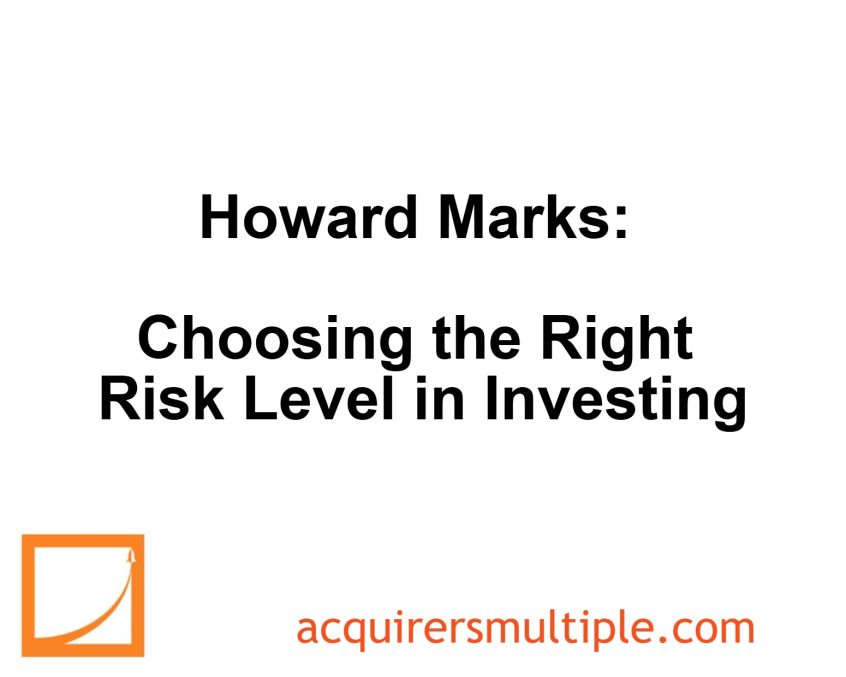In his recent memo titled – Ruminating on Asset Allocation, Howard Marks argues that in an efficient market, the expected return rises proportionally with risk, meaning no position on the risk spectrum is inherently superior—all offer a similar risk-to-return ratio.
This view assumes markets price assets fairly, negating the chance for alpha, or returns from individual skill. Thus, investment outcomes depend on selecting an appropriate risk level rather than seeking superior strategies.
However, Marks contends markets aren’t perfectly efficient; mispricings can occur, enabling skilled managers to achieve better returns. Asset allocation should focus on balancing ownership and debt to align with personal risk goals.
Here’s an excerpt from the memo:
All the foregoing assumes markets are efficient:
- As risk increases in an efficient market, expected return increases proportionally. Or maybe that’s better stated the other way around: as expected return increases, so does the accompanying risk (the uncertainty surrounding the outcome and the likelihood of a bad one). Thus, no position on the risk continuum (for example, in Figure 6) is “better” than any other. It’s all just a matter of where you want to come out in terms of absolute riskiness, or what absolute level of return you want to aim for. The ratio of return to risk is similar at all points on the continuum – less of both toward the left, and more of both toward the right. Said another way, there’s no free lunch.
- Also, looking at each position on the risk continuum, the symmetricalness of the vertical distribution of possible returns around the expected return is similar from one position to the next. That means the ratio of upside potential to downside risk at one position on the continuum isn’t markedly better than it is at other positions – again no free lunch.
- Finally, if you want to move further out on the risk continuum, you can do so by either (a) investing in riskier assets or (b) applying leverage to the same assets (magnifying both the expected return and risk). Again, in a fully efficient market, neither tactic is preferable to the other.
The above three statements capture some of the important implications of supposed market efficiency.
Looked at this way, the only thing that matters is getting to the right risk position for you; under an assumption of market efficiency, there’s nothing to be gained in terms of return at a given level of risk. All ways of getting to a certain risk level will produce the same expected return.
The reason for this is the academic view that, in an efficient market, (a) all assets are priced fairly relative to each other, such that there are no bargains or over-pricings to take advantage of and (b) there’s no such thing as alpha, which I define as “gains resulting from superior individual skill.” As a result, there’s nothing to be gained from active decision making: no asset class, strategy, security or manager is “better” than any other. They merely vary in terms of risk and resulting return.
Also in the academic view, since there’s no such thing as alpha, the only thing that differentiates assets is their beta, or their relative volatility, the extent to which they reflect market movements. In the theory, it’s beta that expected returns are proportional to.
Now it’s time for me to assert strenuously that, in reality, markets are not efficient in the academic sense of always being “right.” Markets may do an efficient job of (a) rapidly incorporating new information and (b) accurately reflecting the resulting consensus opinion concerning the right price for each asset given the totality of information, but that opinion can be far from correct. For that reason, gains can be achieved by choosing skillfully among the options:
- some assets, markets or strategies can offer a better risk/return bargain than others, and
- some managers can operate within a market or strategy to produce superior risk-adjusted returns.
This last idea raises one of the key questions in asset allocation: should you consider departing from your “sweet spot” in terms of risk level in order to invest in a riskier asset class with a manager believed to possess alpha? There’s no easy answer to this question, especially given that many managers who are believed to possess alpha turn out not to.
To conclude, I’ll recap the key points:
- Fundamentally speaking, the only asset classes are ownership and debt.
- They differ enormously in terms of their fundamental nature.
- Ownership assets and debt assets should be combined to get your portfolio to the position on the risk/return continuum that’s right for you. This is the most important decision in portfolio management or asset allocation.
- The other decisions are merely a matter of implementation.
- Of course, your asset allocation process will be informed by how you rate your ability to identify and access superior strategies and superior managers, recognizing that doing so isn’t easy.
You can read the entire memo here:
Howard Marks Memo – Ruminating on Asset Allocation
For all the latest news and podcasts, join our free newsletter here.
Don’t forget to check out our FREE Large Cap 1000 – Stock Screener, here at The Acquirer’s Multiple:



